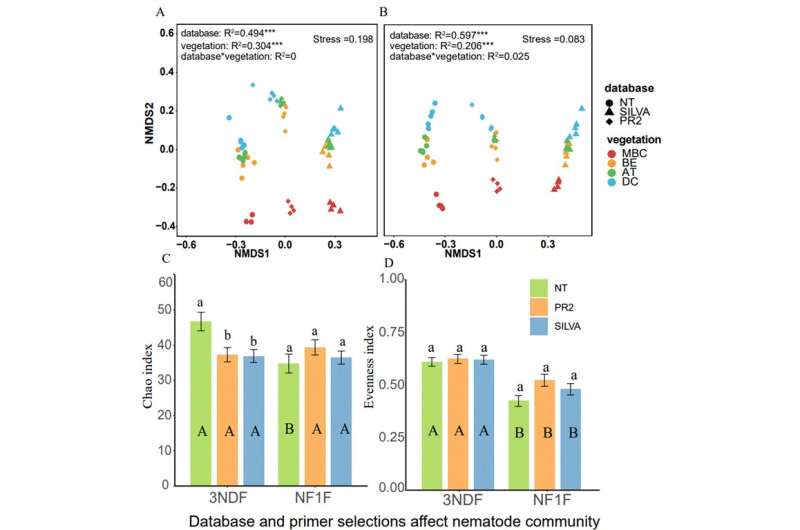New insight into selecting appropriate primers and databases when sequencing soil nematode DNA

Soil nematodes represent a major component of soil communities in terrestrial ecosystems, and play an important role in regulating nutrient cycling and soil health. High-throughput sequencing technology is increasingly used in the study of nematode biodiversity. A recent study demonstrates that the selection of different primers and databases influenced the annotation of nematode taxa, but the diversity of the nematode community showed consistent patterns among different vegetation types.
The study's findings emphasize that it is necessary to select appropriate primers and databases according to the target taxonomic level. The finding appeared in Soil Ecology Letters.
The emergence of high-throughput sequencing has entirely transformed the field of molecular taxonomy, it can capture more details about biodiversity. Even though high-throughput sequencing technology has been in use for more than ten years, the choice of primers and databases will affect the sequencing results. Nonetheless, few studies have comprehensively evaluated the combined impacts of different primers and databases on the identification of nematode communities.
Changbai Mountain offers the largest altitudinal range of well-preserved forest habitats in northeast China. Along the altitude gradient, variable environmental conditions such as temperature, soil moisture and soil pH, have resulted in an obvious trend of biodiversity. Thus, the differences in diversity and composition of soil nematode communities in Changbai Mountain provide an ideal platform to verify the influence of different primers and databases on the annotation of nematode sequencing.
The study compared two pairs of primers (3NDf/C_1132rmod and NF1F/18Sr2bR) and three databases (NT_v20200604, Silva138/18s Eukaryota and PR2_v4.5 databases) to investigate the nematode communities in different vegetation types along the elevational gradient of Changbai Mountain.
For 3NDF primer, the number of annotated taxa was different among the three databases at the genus and species levels; while for NF1F primer, significant differences were found at the family level among the three databases. Among different databases, differences were also discovered in the nematode taxa.
The finer the taxonomic level, the fewer taxa were shared by the three databases. The distribution patterns of nematode diversity obtained by different primers and databases were similar among different vegetations. Therefore, when choosing primers and databases, we should pay more attention to the classification level according to our actual needs. In terms of annotation effect in this study, 3NDF primers with NT database could provide more information than other combinations at the genus or species levels.
This study suggests that when the main goal is the investigation of species composition and taxonomy, the sequencing method still suffers from poor consistency, so traditional microscopic identification is still indispensable. Therefore, further validation and studies are needed in the future to compare the consistencies of the morphological and molecular methods in-depth. In addition, despite the rapid development of molecular techniques, some databases still have incomplete information. In the future, we should supplement more primers and database information to further improve the accuracy of molecular analysis in nematode ecological research.
More information: Yixin Sun et al, Database and primer selections affect nematode community composition under different vegetations of Changbai Mountain, Soil Ecology Letters (2022). DOI: 10.1007/s42832-022-0153-3
Provided by Higher Education Press




















